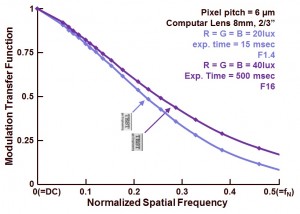In the previous blog, the measurement of the Modulation Transfer Function by means of the Siemens star was explained. In this blog, this method will be applied to check out the effect of the lens F-number on the MTF.
In Figure 1 the result of the MTF measurement is shown.
Figure 1 : Modulation Transfer Function for two settings of the lens F-number.
It is quite nice to see the influence of the F-number :
- a low F-number is referring to a large lens opening (= a lot of light goes to the sensor, a short exposure time is needed), and in that case the incoming light is reaching the sensor with a large chief-ray angle (= deviation from the normal),
- a large F-number is referring to a small lens opening (= much less light goes to the sensor, a long exposure time is needed), and in that case the incoming light is reaching the sensor with a small chief-ray angle (= almost perpendicular to the sensor).
Light that is perpendicularly reaching the sensor will suffer less from optical cross-talk in comparison to light that is reaching the sensor under a certain angle and is deviating more from the normal. More (optical) cross-talk does result in less contrast between neighbouring pixels, thus lowering the MTF for larger spatial frequencies. And this effect is observed in Figure 1 !
Next time something about colour and MTF.
Albert, 25-03-2014.
